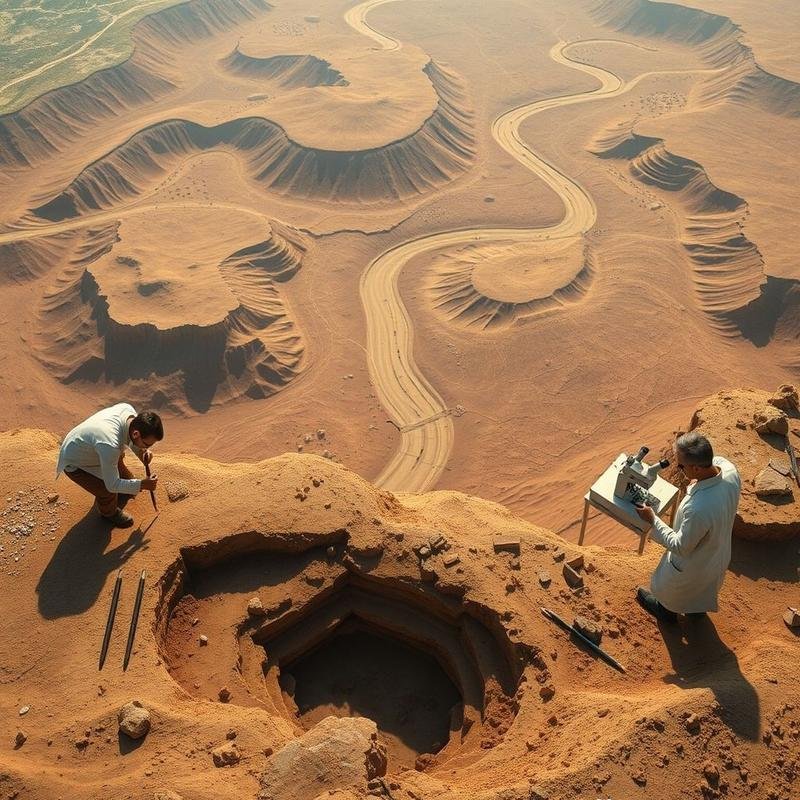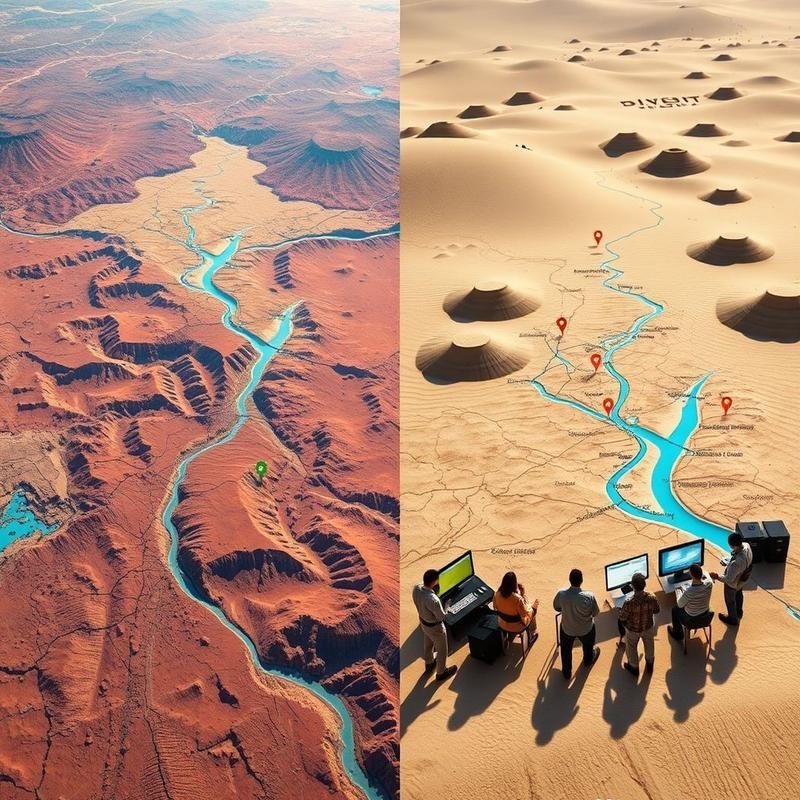Lost Rivers, Lost Worlds: Are We Facing a Similar Fate?

Lost Civilizations: A Warning from Vanished Rivers
Across millennia, the desert wind carries echoes of civilizations consumed by the earth. Their lifeblood, once mighty rivers, has vanished, leaving behind spectral remnants of their former grandeur. Paradoxically, modern climate change, a force threatening our own future, is unearthing these lost worlds, compelling us to confront the unsettling echoes of history.
The Lost City of Krorän: A Silk Road Oasis
Our exploration begins in the heart of Central Asia, within the desolate expanse of the Taklamakan Desert, where the forgotten city of Krorän, also known as Loulan, lies buried beneath shifting dunes. Once a vibrant oasis and a crucial Silk Road trading post, Krorän flourished for centuries, its fate inextricably linked to the waters of the Tarim River. Around the 4th century AD, the Tarim, Krorän’s lifeline, altered its course, leading to the city’s decline, the dispersal of its inhabitants, and the fading of its story into legend.
Rediscovering the Past: Modern Technology Unveils Ancient Secrets
The rediscovery of Krorän is a compelling narrative in itself. In 1900, driven by accounts of a lost city, Swedish explorer Sven Hedin excavated the ruins, revealing remarkably well-preserved artifacts – wooden structures, textiles, and documents in ancient scripts – remnants of a sophisticated society. However, Hedin’s discovery was merely the initial step. The full extent of Krorän’s history and the reasons for its demise remained shrouded in mystery for over a century.
Modern technology is now elucidating the intricate web of environmental factors that contributed to Krorän’s downfall. Satellite imagery, from missions such as Landsat and Sentinel, enables scientists to map ancient riverbeds and irrigation canals with unprecedented precision. Geophysical surveys, employing techniques like ground-penetrating radar, are uncovering buried structures and providing insights into the city’s layout and infrastructure. These tools are not only revealing the physical remains of Krorän but also illuminating the delicate equilibrium between civilization and environment that sustained, and ultimately failed, the city.
The Tarim River: Krorän’s Lifeline and Downfall
The story of Krorän is inextricably linked to the Tarim River, a vast inland river system fed by the glaciers of the surrounding mountain ranges. For centuries, the Tarim provided Krorän with a reliable water source for agriculture and daily life. The inhabitants of Krorän were skilled engineers, developing ingenious irrigation systems to channel the river’s waters to their fields. Archaeological evidence reveals a complex network of canals and dams, designed to maximize water use and minimize waste. They cultivated crops such as wheat, barley, and millet, sustaining a population that may have numbered several thousand at its peak.
However, the Tarim River’s flow was not constant, fluctuating naturally due to climate variability and tectonic activity. Around the 4th century AD, a confluence of factors led to a dramatic shift in the river’s course. Geological shifts, coupled with increased evaporation due to regional warming, resulted in the Tarim abandoning its original channel and flowing northwards, away from Krorän.
The consequences for Krorän were devastating. As the water supply dwindled, the city’s agricultural productivity plummeted, leading to food shortages and widespread famine. The population began to migrate, seeking more hospitable lands. By the end of the 4th century, Krorän was largely abandoned, its once-thriving streets silent, its buildings slowly being engulfed by the encroaching desert.
The Role of Climate Change and Human Activity
Scientific consensus attributes the Tarim River’s change of course to a combination of natural variability and human-induced degradation. A 2010 study published in the Journal of Geophysical Research (Chen et al., 2010) analyzed sediment cores from the Tarim Basin, revealing evidence of increased aridity and reduced river flow during the late Holocene period, coinciding with Krorän’s decline. Human activities, such as deforestation and overgrazing, may have exacerbated the problem, leading to increased soil erosion and reduced water retention in the surrounding landscape. A separate study in Quaternary Science Reviews (Li et al., 2014) suggests that large-scale irrigation projects upstream of Krorän may have also contributed to the river’s decline, diverting water away from the city and disrupting the natural hydrological cycle.
Echoes of the Past: Other Civilizations Lost to Vanished Rivers
The story of Krorän is not unique. Across the globe, countless examples exist of civilizations that rose and fell with the ebb and flow of rivers. In Mesopotamia, the Sumerian cities of Ur and Uruk flourished for millennia, sustained by the fertile lands irrigated by the Tigris and Euphrates rivers. However, changes in the river courses, combined with soil salinization caused by unsustainable irrigation practices, eventually led to the decline of these once-mighty city-states. The Akkadian Empire, which succeeded the Sumerians, also faced environmental challenges, including prolonged droughts that contributed to its collapse around 2200 BC.
In the Indus Valley, the Harappan civilization, one of the most advanced societies of the ancient world, thrived along the banks of the Indus River and its tributaries. The Harappans built sophisticated cities with advanced drainage systems and irrigation networks. However, around 1900 BC, the Indus River system underwent significant changes, possibly due to tectonic activity or climate change. The Ghaggar-Hakra River, a major tributary of the Indus, dried up, leading to widespread drought and the collapse of the Harappan civilization.
The Maya civilization of Central America, known for its impressive cities and sophisticated calendar system, also faced environmental challenges related to water management. Prolonged droughts, exacerbated by deforestation and unsustainable agricultural practices, are believed to have contributed to the decline of the Maya civilization in the 9th century AD. Recent studies of stalagmites in Maya caves have revealed evidence of severe droughts during this period, coinciding with the abandonment of major Maya cities.
A Warning for the Future: Are We Heeding the Lessons of History?
These historical examples serve as stark warnings about the fragility of civilizations in the face of environmental change. They demonstrate that even the most advanced societies are vulnerable to the vagaries of climate and the consequences of unsustainable resource management. But are we, in the 21st century, any wiser than our ancestors? Are we heeding the lessons of the past, or are we doomed to repeat the mistakes that led to the collapse of Krorän and other lost civilizations?
The parallels between the past and the present are undeniable. Today, we are facing a global climate crisis driven by human activity. The burning of fossil fuels is releasing greenhouse gases into the atmosphere, causing temperatures to rise, glaciers to melt, and sea levels to rise. These changes are already having a profound impact on water resources around the world. Rivers are drying up, lakes are shrinking, and droughts are becoming more frequent and severe.
In the American Southwest, the Colorado River, which supplies water to 40 million people in seven states, is facing a severe crisis. Decades of overuse, combined with climate change, have reduced the river’s flow to historic lows. Lake Mead and Lake Powell, the two largest reservoirs on the Colorado River, are at record low levels, threatening water supplies for cities and farms across the region. In Africa, the shrinking of Lake Chad, once one of the largest lakes in Africa, is contributing to conflict and displacement. Climate change, combined with unsustainable water management practices, has reduced Lake Chad to a fraction of its former size, threatening the livelihoods of millions of people who depend on it for water and agriculture. In Asia, the melting of Himalayan glaciers is threatening the water supplies of hundreds of millions of people who depend on rivers like the Indus, the Ganges, and the Brahmaputra. As the glaciers shrink, the flow of these rivers is declining, leading to water shortages and increased competition for resources.
A Call to Action: Learning from the Past to Build a Sustainable Future
The story of Krorän, and the other lost river civilizations, is a powerful reminder of the interconnectedness between human societies and the environment. It underscores the importance of sustainable resource management and the need to adapt to changing environmental conditions. If we fail to learn from the past, we risk repeating the mistakes that led to the downfall of these civilizations.
But there is still hope. We have the knowledge, the technology, and the resources to address the climate crisis and build a more sustainable future. We can transition to renewable energy sources, improve water management practices, and promote sustainable agriculture. We can also learn from the past, studying the successes and failures of ancient civilizations to inform our own strategies for adaptation and resilience.
The rediscovery of Krorän, and other lost river civilizations, is not just an archaeological endeavor; it is a call to action. It is a reminder that the choices we make today will determine the fate of our own civilization. Will we heed the warnings of the past, or will we continue down a path of environmental destruction? The answer lies in our hands.
The desert wind continues to whisper, carrying the echoes of a forgotten past. Krorän serves as a potent symbol, resurrected by the very forces that threaten us today. Is its fate a cautionary tale, or an inevitable prophecy? What lessons do you believe Krorän holds for our future? Share your thoughts in the comments below, and let’s learn from history, before history repeats itself.
Watch: The Story of Lost Civilizations
Images of Lost Worlds








